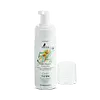What's inside
What's inside
 Key Ingredients
Key Ingredients

 Benefits
Benefits

 Concerns
Concerns

 Ingredients Side-by-side
Ingredients Side-by-side

Water
Skin ConditioningSodium Lauroyl Oat Amino Acids
CleansingAnthemis Nobilis Flower Water
MaskingLavandula Angustifolia Flower Water
Skin ConditioningSucrose Laurate
EmollientSucrose Dilaurate
EmollientSucrose Trilaurate
EmulsifyingHydrogenated Starch Hydrolysate
HumectantGlycerin
HumectantRosa Damascena Flower Water
MaskingMagnesium Aspartate
Skin ConditioningZinc Gluconate
Skin ConditioningCopper Gluconate
Skin ConditioningChondrus Crispus Extract
Skin ConditioningLonicera Caprifolium Flower Extract
PerfumingLonicera Japonica Flower Extract
Skin ConditioningBetaine
HumectantSodium Hyaluronate
HumectantChamomilla Vulgaris Extract
Skin ProtectingLactic Acid
BufferingTocopherol
AntioxidantBeta-Sitosterol
Emulsion StabilisingSqualene
EmollientCalendula Officinalis Extract
Skin ConditioningMentha Piperita Extract
CleansingWater, Sodium Lauroyl Oat Amino Acids, Anthemis Nobilis Flower Water, Lavandula Angustifolia Flower Water, Sucrose Laurate, Sucrose Dilaurate, Sucrose Trilaurate, Hydrogenated Starch Hydrolysate, Glycerin, Rosa Damascena Flower Water, Magnesium Aspartate, Zinc Gluconate, Copper Gluconate, Chondrus Crispus Extract, Lonicera Caprifolium Flower Extract, Lonicera Japonica Flower Extract, Betaine, Sodium Hyaluronate, Chamomilla Vulgaris Extract, Lactic Acid, Tocopherol, Beta-Sitosterol, Squalene, Calendula Officinalis Extract, Mentha Piperita Extract
Squalane
EmollientWater
Skin ConditioningCoco-Caprylate/Caprate
EmollientGlycerin
HumectantSucrose Stearate
EmollientEthyl Macadamiate
Skin ConditioningCaprylic/Capric Triglyceride
MaskingSucrose Laurate
EmollientHydrogenated Starch Hydrolysate
HumectantSucrose Dilaurate
EmollientSucrose Trilaurate
EmulsifyingPolyacrylate Crosspolymer-6
Emulsion StabilisingIsoceteth-20
EmulsifyingSodium Polyacrylate
AbsorbentTocopherol
AntioxidantHydroxymethoxyphenyl Decanone
Skin ConditioningTrisodium Ethylenediamine Disuccinate
Malic Acid
BufferingEthylhexylglycerin
Skin ConditioningChlorphenesin
AntimicrobialSqualane, Water, Coco-Caprylate/Caprate, Glycerin, Sucrose Stearate, Ethyl Macadamiate, Caprylic/Capric Triglyceride, Sucrose Laurate, Hydrogenated Starch Hydrolysate, Sucrose Dilaurate, Sucrose Trilaurate, Polyacrylate Crosspolymer-6, Isoceteth-20, Sodium Polyacrylate, Tocopherol, Hydroxymethoxyphenyl Decanone, Trisodium Ethylenediamine Disuccinate, Malic Acid, Ethylhexylglycerin, Chlorphenesin
 Reviews
Reviews

Ingredients Explained
These ingredients are found in both products.
Ingredients higher up in an ingredient list are typically present in a larger amount.
Glycerin is already naturally found in your skin. It helps moisturize and protect your skin.
A study from 2016 found glycerin to be more effective as a humectant than AHAs and hyaluronic acid.
As a humectant, it helps the skin stay hydrated by pulling moisture to your skin. The low molecular weight of glycerin allows it to pull moisture into the deeper layers of your skin.
Hydrated skin improves your skin barrier; Your skin barrier helps protect against irritants and bacteria.
Glycerin has also been found to have antimicrobial and antiviral properties. Due to these properties, glycerin is often used in wound and burn treatments.
In cosmetics, glycerin is usually derived from plants such as soybean or palm. However, it can also be sourced from animals, such as tallow or animal fat.
This ingredient is organic, colorless, odorless, and non-toxic.
Glycerin is the name for this ingredient in American English. British English uses Glycerol/Glycerine.
Learn more about GlycerinWe don't have a description for Hydrogenated Starch Hydrolysate yet.
Sucrose Dilaurate isn't fungal acne safe.
Sucrose Laurate isn't fungal acne safe.
Sucrose Trilaurate isn't fungal acne safe.
Tocopherol (also known as Vitamin E) is a common antioxidant used to help protect the skin from free-radicals and strengthen the skin barrier. It's also fat soluble - this means our skin is great at absorbing it.
Vitamin E also helps keep your natural skin lipids healthy. Your lipid skin barrier naturally consists of lipids, ceramides, and fatty acids. Vitamin E offers extra protection for your skin’s lipid barrier, keeping your skin healthy and nourished.
Another benefit is a bit of UV protection. Vitamin E helps reduce the damage caused by UVB rays. (It should not replace your sunscreen). Combining it with Vitamin C can decrease sunburned cells and hyperpigmentation after UV exposure.
You might have noticed Vitamin E + C often paired together. This is because it is great at stabilizing Vitamin C. Using the two together helps increase the effectiveness of both ingredients.
There are often claims that Vitamin E can reduce/prevent scarring, but these claims haven't been confirmed by scientific research.
Learn more about TocopherolWater. It's the most common cosmetic ingredient of all. You'll usually see it at the top of ingredient lists, meaning that it makes up the largest part of the product.
So why is it so popular? Water most often acts as a solvent - this means that it helps dissolve other ingredients into the formulation.
You'll also recognize water as that liquid we all need to stay alive. If you see this, drink a glass of water. Stay hydrated!
Learn more about Water